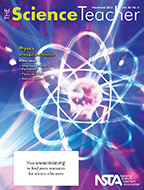Physics
By Mary Bigelow
Posted on 2013-11-17
 If you’re not a high school physics teacher, don’t put this issue aside! There are many ideas for interdisciplinary activities and strategies that apply to other subjects and grade levels. And many of them can be done even on a shoestring budget.
If you’re not a high school physics teacher, don’t put this issue aside! There are many ideas for interdisciplinary activities and strategies that apply to other subjects and grade levels. And many of them can be done even on a shoestring budget.
What Happens When You Flip a Switch? describes several activities for students to explore the nature of energy and how energy is produced. The author notes that these activities can be used by biology, earth science, and chemistry teachers as a introduction to topics in those subject areas. [SciLinks: Conservation of Energy, Kinetic Energy, Heat Engines]
We teachers want our students to experience success. In Rethinking Failure, the author makes a case for how “getting it wrong can increase students’ chances for getting it right” and “constructing meaning trumps being presented with meaning.” During a lesson on projectile motion, students made predictions, collected data, and discussed their misconceptions. The article provides some common misconceptions in other science subjects. [SciLinks: Projectile Motion]
Occasionally on the NSTA listserves and discussion forums, teacher pose questions about doing science activities with a limited budget. Inexpensive Equipment for the Physics Classroom* show how to make a ramp and use it for many activities related to physics concepts. In an era of sophisticated simulations and video games, this seeming simple project lets students experience these concepts first-hand. [SciLinks: Forces, Motion, Vectors, Acceleration]
Living in central Pennsylvania, I was interested in the simple Amish pull toy that forms the basis of the exploratory activity described in Toying Around*. Figuring out how the toy works is a version of the “mystery box” that is often used with younger students. Both of these strategies show students how scientists often must use indirect evidence to explain phenomena and draw conclusions. The authors note that they did this the day before a holiday break—a good use of this time—and suggest that it could also be a introductory activity on the nature of science. (And, yes, they do provide instructions for making the toy!)
Portfolios have been around for a while, but the authors of Physics Portfolios* show us what portfolio projects “look like” in a real classroom. They describe the components of the students’ portfolios and summarize this in a easy-to-understand table: unit pictures and essays, study guides, self-evaluations and evidence of learning, projects, and reflective essays (a rubric is available). The ideas could be adapted to other subjects.
Other articles of interest:
- Gamify AP Biology (Science 2.0) features an interview with Paul Anderson, the creator of the Bozeman Science series of science videos He describes his efforts to add elements of gaming to his biology classes.
- Why Care About Wetlands? (The Green Room) has resources for helping students learn the value of these “ecological treasures.” [SciLinks: Wetlands]
- Pushing Caffeine to Teens [SciLinks: Caffeine]
- This issue’s Career of the Month features an interview with a microscopist. The article notes two sites that have been featured in SciLinks: MicroscopyU and Molecular Expressions.
*Don’t forget to look at the Connections for this issue (November 2013). Even if the article does not quite fit with your lesson agenda, this resource has ideas for handouts, background information sheets, data sheets, rubrics, etc.
Disclaimer: The views expressed in this blog post are those of the author(s) and do not necessarily reflect the official position of the National Science Teaching Association (NSTA).


